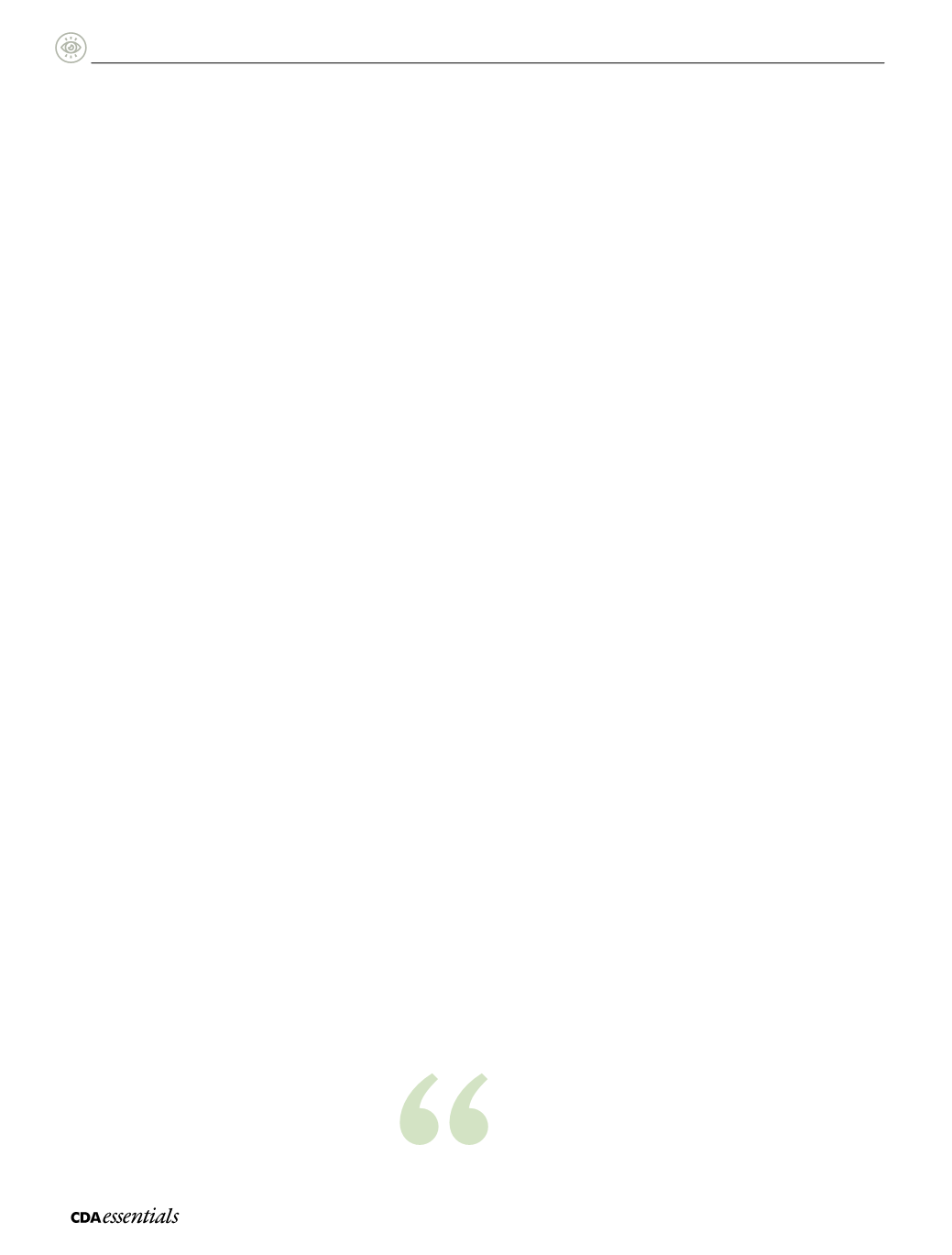
24
|
Volume1 Issue3
I
ssues and
P
eople
7%of the total healthcarebudget
inCanada (includingphysicians’
fees, hospital costs andprescription
drugs).
12
Nonetheless,webelieve that
in thecurrent climateof restrained
government spendingonhealthcare,
anewgovernment-fundeddental
program for allwill have littleor no
political appeal.
FragmentedCoverage
Medical services inCanadaarefinanced
throughpublic funds,whiledental
services arefinanceddirectlyby
patients—either directly todentists
or indirectly throughmultipleprivate
insurancecompanies. The relatively
small dental insurancemarket in
Canada isdispersedamongmultiple
private insurers, andcollectively
accumulateshigher overheadand
administrativecosts than itwouldbe
if administeredbya singleprovider.
13
Consequently, thepremium rates for
dental insurance remainout of range
formost low-incomepeople. Publicly
financeddental plans areavailable
tohouseholdson social assistance
in someCanadian jurisdictions,
14-16
but theyare typicallyassociatedwith
low remunerationandcomplicated
paperwork for dentists, and the
patients areoftennoncompliant to
appointment schedulesor treatment
recommendations.
8
Consolidation
We recommendagovernment-
administered systemof dental
insuranceas a tax-deductibleplan
across thecountry for all Canadians.
Employerswouldcontribute to the
premiumsof their employees, as they
donow, andeveryoneelsecould
contribute individually to theplan.
Governmentswould subsidize the
premiumsof people receiving social
welfare. It is important to recognize that
thisplan ismoreakin toapensionplan
thanagovernment tax. Eachprovincial
and territorial governmentwould
act as local underwriters tofinance
and invest thepremiums. Given that
administrativecosts andexpenditures
per capita in theCanadianpublicly
administeredmedical insurance system
areabout half thecorresponding
costs for themixof publicandprivate
healthcarefinancing in theUnited
States,
17,18
weexpect similar savings
for agovernment-sponsoreddental
plan. Current employer-sponsored
dental insurancebenefits arenot taxed
(except inQuebec), a situation that in
2006amountedcollectively toa loss in
tax revenueof about $2.6billion.
5
With
thisuniversal dental plan, thepooled
contributionswouldgeneratefinancial
interest tooffset this loss in tax revenue
anddefraymost of theadministrative
costs, thereby sustaining the system
with littleor no impact ongovernment
reserves.
PoolingofRisk
Private insurersprefer tocover
healthy rather thanunhealthypeople,
and tend to favour thosewhoare
relativelyaffluent.
19,20
Premiumsusually
increasewithadvancingagebecause
of apresumedgreater health risks.
Inaddition, someprivate insurers
adjust for riskswithadiversityof
options,whichadds further to their
administrativecomplexityandcost.
21
Consequently,manypeoplecannot or
choosenot tomaintain their private
dental insuranceupon retirement.
22
Thus, theprivate insurance system
consistentlyexhibits a strong income–
utilizationgradient, as they tend
toexclude low-incomepeople,
23
a
trend thatwas identifiedby theRoyal
CommissiononHealthServices in
1961 (which led to the1966Medical
CareAct),
24
andagainby the recent
CanadianHealthMeasures Survey
(2007–2009).
25
Apparently, access to
dentistryhasnot improvedmuch
over thepast half-centurydespite the
growthof private insurance.
Withinour proposal for auniversal and
publiclyadministereddental plan, all
Canadian residents, except thosewho
wish toopt out,wouldbecoveredat
financiallyaffordable rates, regardless
of age, healthor employment status.
After retirement, peoplecouldcontinue
tocontribute to theplan, according
topersonal capacity. This sharing
of financial riskwouldeliminate the
adverse selection that occurswhen
the insuredgroupconsistsmostlyof
peopleat higher risk todisease.
26
It
alsoallowsdistributionof thecost of
oral care justlyandaffordablyacross
thepopulation. The2003Canadian
CommunityHealthSurveyestimated
that dental insurance for low-income
Canadianswould reduce the inequity
associatedwithpreventivedentistryby
about one-third.
27
Dental insurance for
all Canadianswould further lessen the
inequity in services currentlyafflicting
the frail elderlypopulation.
Cost-Effectiveness ofDisease
Prevention
Dentistry iswidelyperceivedas
expensive, andmanypeopleon
low incomearepredisposed touse
emergency rather thanpreventive
services.
28
Inoneprovince, these
emergency treatments,whichwere
mostlypreventable, costOntario
residents about $16millionayear in
2006,withoutmuchaddress to the
underlyingdental problems.
29
Indeed,
theamount ofmoney spent ondental
servicesbypeoplewithout dental
insurance isquite similar to that spent
by thosewith insurance.
12
Webelieve,
therefore, that auniversal dental plan
toall citizens, includingolder people,
will eliminate this inequitybyhelping
tomaintainoral healthawareness,
encouragepreventivecare, and reduce
emergencyandother costlydental
treatments as frailty increases.
30-32
Privatevs.PublicCareSystem
Proponentsof adual publicand
privatehealthcare systembelieve that
subsidizedpublic services inevitably
Inequity in oral care arisesfromfinancial, behavioural
and physical barriers, and remains a challenge for olderCanadians.


